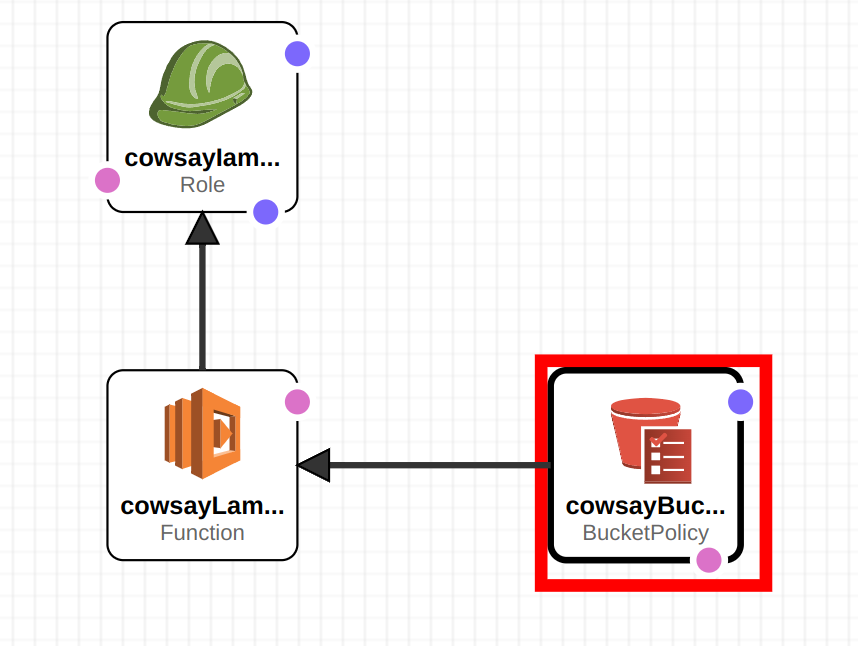AWS Serverless: Difference between revisions
| Line 220: | Line 220: | ||
</syntaxhighlight> | </syntaxhighlight> | ||
We need to create a function. We create a package and function | We need to create a function. We create a package and function | ||
=Uploading the code= | |||
We need to upload the code to the S3Bucket we created above. We need to zip it up making sure that index.js is at the root and not in a folder. Remember you need the code as well. It does not build it in the cloud. | |||
<syntaxhighlight lang="bash"> | |||
cd <myproject> | |||
zip -r cowsay.zip * | |||
</syntaxhighlight> | |||
We can upload it by right-clicking lambda and choosing upload lambda | |||
=Running the Code= | |||
To run the code locally type | |||
<syntaxhighlight lang="bash"> | |||
sam local invoke | |||
</syntaxhighlight> | |||
To run the code on AWS right click on the lambda within AWS Explorer in VS Code | |||
Revision as of 03:04, 19 February 2022
Introduction
This is an example of how to set up a serverless framework function within AWS
Setup
Within AWS there are example templates for each piece of the infrastructure. For this we need to create a
- S3 Bucket to hold the code
- IAM::Role to describe the permissions
- Lambda The function to run
- Bucket Policy This grants access from the bucket to the lambda function
Templates
Here are the templates I used. I have highlighted where they differ from the provided examples
Stack cowsay-bucket
S3 Bucket
Example can be found here
This needs to be in its own stack and create prior to the other resources.
{
"Resources": {
"cowsayBucket": {
"Type": "AWS::S3::Bucket",
"Properties": {
"BucketName": "cowsayBucket"
}
}
}
}
Stack cowsay-lambda
This stack or group of resources holds the lamda, bucket policy and role. The lambda function references the bucket created above.

IAM::Role
Example can be found here
{
"Resources": {
"cowsayIamRole": {
"Type": "AWS::IAM::Role",
"Properties": {
"AssumeRolePolicyDocument": {
"Version": "2012-10-17",
"Statement": [
{
"Effect": "Allow",
"Principal": {
"Service": [
"lambda.amazonaws.com"
]
},
"Action": [
"sts:AssumeRole"
]
}
]
},
"Path": "/",
"Policies": [
{
"PolicyName": "root",
"PolicyDocument": {
"Version": "2012-10-17",
"Statement": [
{
"Effect": "Allow",
"Action": [
"logs:*"
],
"Resource": "arn:aws:logs:*:*:*"
}
]
}
}
]
}
}
}
}
Lambda Function
Example can be found here
{
"Resources": {
"cowsayLambda": {
"Type": "AWS::Lambda::Function",
"Properties": {
"Code": {
"S3Bucket": "cowsaybucket",
"S3Key": "cowsay.zip"
},
"Handler": "index.handler",
"Runtime": "nodejs14.x",
"Role": {
"Fn::GetAtt": [
"cowsayIamRole",
"Arn"
]
}
}
}
}
}
Adding the Role to the Lambda
Now we have the base templates we need to add properties to allow them to interact
{
"Resources": {
"cowsayBucket": {
"Type": "AWS::S3::Bucket",
"Properties": {
"BucketName": "cowsayBucket"
}
},
"Role": {
"Ref": "cowsayIamRole"
}
}
}
Bucket Policy
We need to allow lambda function access to the bucket. We do this with a the bucket
{
"Resources": {
"cowsayBucketPolicy": {
"Type": "AWS::S3::BucketPolicy",
"Properties": {
"Bucket": "cowsaybucket",
"PolicyDocument": {
"Statement": [
{
"Effect": "Allow",
"Principal": {
"Service": "serverlessrepo.amazonaws.com"
},
"Action": "s3:GetObject",
"Resource": "arn:aws:s3:::cowsaybucket/*",
"Condition": {
"StringEquals": {
"aws:SourceArn": {
"Fn::GetAtt": [
"cowsayLambda",
"Arn"
]
}
}
}
}
]
}
}
}
}
}
The Code
Do do this we
- Create a node js package
- Create a function
- Create a template to run it locally
Create a node js package
Just a straight forward package
{
"name": "cowsay",
"version": "1.0.0",
"description": "",
"main": "index.js",
"scripts": {
"test": "echo \"Error: no test specified\" && exit 1"
},
"author": "",
"license": "ISC",
"dependencies": {
"cowsay": "^1.4.0"
}
}
Create a function
const cowsay = require('cowsay');
exports.handler = function(event, context) {
// Get a cow from cowsay!
let cow = cowsay.say({
text: "I'm a lambda moooodule",
e: "oO",
T: "U "
});
// Replace line breaks to HTML line breaks
cow = cow.replace(/[\n|\r|\n\r]/g, '<br />');
// Create the HTML
var html = '<html><head><title>Cowsay Lambda!</title></head>' +
`<body><h1>Welcome to Cowsay Lambda!</h1>${cow}</body></html>`;
// New Source 1
// Return the HTML response
context.succeed(html);
};
Create a template to run it locally
See here for documentation.
AWSTemplateFormatVersion: '2010-09-09'
Transform: 'AWS::Serverless-2016-10-31'
Description: An AWS Serverless Specification template describing your function.
Resources:
myfirstlambda:
Type: 'AWS::Serverless::Function'
Properties:
Handler: index.handler
Runtime: nodejs14.x
CodeUri: .
Description: ''
MemorySize: 128
Timeout: 3
We need to create a function. We create a package and function
Uploading the code
We need to upload the code to the S3Bucket we created above. We need to zip it up making sure that index.js is at the root and not in a folder. Remember you need the code as well. It does not build it in the cloud.
cd <myproject>
zip -r cowsay.zip *
We can upload it by right-clicking lambda and choosing upload lambda
Running the Code
To run the code locally type
sam local invoke
To run the code on AWS right click on the lambda within AWS Explorer in VS Code